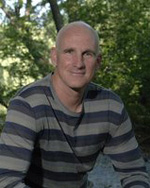Our Green Grade
CAS Prof Cleveland says BU needs to clean up its environmental act

When Cutler Cleveland talks about the energy it takes to get a degree at Boston University, he’s not talking about the readings, the lectures, the lab work, and the problem sets. He doesn’t mean office hours with professors or long nights of studying. Instead, the College of Arts and Sciences professor of geography and the environment is referring to the energy used to light the lecture halls, operate the lab equipment, power the computers, and otherwise keep BU’s academic, administrative, and research engines running.
Last spring, one of Cleveland’s classes conducted an audit of BU’s environmental impact — its energy use, greenhouse gas emissions, solid waste disposal, and water usage, among other items. The class, made up of undergraduates and grad students, concluded that while BU has recently made efforts to be more eco-friendly, it still has a long way to go. On Wednesday, October 24, about 75 people gathered in a CAS lecture hall to hear Cleveland present the results of the audit’s energy and emissions portion.
He told his audience that he initiated the audit to nudge BU’s institutional behavior to better align with the lessons taught in its labs and lecture halls. “We teach hundreds of students in classes all over BU about the importance of environmental and energy issues,” he said, “but we often see University policies and behaviors that are at odds with that.”
Cleveland and his students gathered data from several BU departments, including the Charles River Offices of Environmental Health and Safety, Purchasing Services, and Facilities Management and Planning, dating from 1991 through 2006. They found that during those years, total energy use jumped more than 50 percent, to about 1.5 trillion British thermal units (Btus) of energy annually. Meanwhile, greenhouse gas emissions nearly quadrupled, to about 400 metric tons in 2006.
The overwhelming reason for the dramatic increases, Cleveland said in an interview, was the expansion of BU during those 15 years, when the Charles River Campus grew from about 7 million square feet to more than 10 million square feet.
“That means more people, more buildings, and a significant increase in funded research, which requires labs, computers, and other facilities, all needing energy,” he said.
But the University’s expansion doesn’t tell the whole story. According to the audit, BU’s per capita environmental impact also intensified during this period, with energy use jumping more than 40 percent, to about 55 million Btus, for every full-time student, faculty member, and staff person, and per capita greenhouse gas emissions more than tripling.
Cleveland did emphasize recent investments BU has made in improving energy efficiency — from shifting to cleaner-burning natural gas at its two boiler plants to retrofitting lighting systems with more efficient fixtures and compact fluorescent bulbs. Such efforts are detailed on a Web site for “greening” BU, launched last spring by Michael Field, a University assistant provost. The site, which also has tips for individual energy saving and recycling, points out that between 1990 and 2006 facilities upgrades cut BU’s energy use by 11.6 million kilowatts, reduced fuel oil use by nearly 720,000 gallons, and saved the University about $3.6 million in utility bills.
“The increase in energy use would have been much greater if it hadn’t been for those efforts,” said Cleveland, who also noted that BU has significantly reduced emissions of pollutants such as sulfur dioxide and nitrogen oxide, non–greenhouse gases regulated by state and federal environmental agencies.
But he stressed that the University lacks a coherent energy policy. “These efforts, while laudable, have largely been ad hoc,” Cleveland said.
Those sentiments were echoed by Elijah Ercolino (ENG’09), a mechanical engineering graduate student and vice president of the BU Energy Club, which promoted Cleveland’s presentation.
“There’s no excuse why BU is not a world leader among universities in this, with an energy strategy that educates students and inspires others,” said Ercolino.
Indeed, Cleveland found BU “lagging” when compared to several peer universities, among them New York University, the University of Pennsylvania, and Tufts, in terms of initiatives to purchase green power, develop an energy strategy, increase energy efficiency beyond normal maintenance and upkeep, and institute policies to reduce greenhouse gas emissions.
Jesse Ram (GRS’08), one of the students who worked on the audit, said he hoped their findings would spur BU’s administration to invest in better technologies with new buildings and in energy-efficient retrofits. “Anybody who goes to BU notices there are a lot of old buildings,” said Ram, “and those buildings are energy drains.”
Still, when it comes to responsibility for BU’s voracious energy consumption, Cleveland didn’t let students off the hook. He cited anecdotal evidence of “more energy-intensive lifestyles,” with vastly more computers and other personal electronics being used by students in the last 15 years. “I’ve been in the dorm rooms,” he said. “There are power strips hanging everywhere.”
Cleveland will present the rest of the audit’s findings in the months ahead, but has not yet scheduled these discussions. In the meantime, he has forwarded a copy of the full report to University President Robert A. Brown and Provost David Campbell. And he plans to investigate the broad findings in greater detail and to look into issues that weren’t covered in the initial audit, such as transportation. He said he hoped the audit would be a step toward putting pressure on BU to develop a greener energy strategy.
“It struck me that just on energy, we have this amazing amount of intellectual capital in this university that’s underutilized,” Cleveland told the audience, suggesting, for example, that BU sponsor small seed grants for demonstration projects by students and faculty to improve energy efficiency at the University.
“It’s a systemwide need,” he said. “There needs to be education and awareness from below and leadership from the top.”
Chris Berdik can be reached at cberdik@bu.edu.